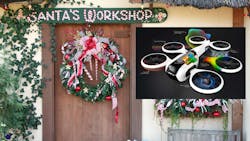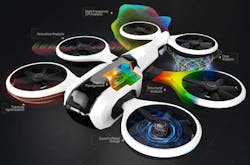Santa’s Workshop Gets a Boost from AI, 3D Printers and Drones
Due to social distancing guidelines at the North Pole, Santa’s workforce has been working remotely during the workshop’s busiest time of year. To aid those efforts, St. Nick recently instituted a new Remote Reindeer Workforce (RRW), which uses Siemens’ Digital Industries Software along with Maya HTT’s simulation, lifecycle management, ECAD/MCAD and AI solutions to help the herd of Christmas reindeer streamline the biggest delivery mission of the year.
Christmas-optimized drones, which would come with their own set of unique challenges, will lend a hand to the reindeer. The drone design underwent simulation testing and validation before the North Pole team built the prototype.
Challenge 1: Drone Design
Travel alone posed a huge challenge for Santa’s drone fleet. Traversing different terrains and aerodynamic scenarios were among the biggest challenges. Santa’s engineering elves leveraged additive manufacturing to create a drone skeleton designed to stabilize and provide optimal drag and lift in various environments.
By using 3D printers, the engineering elves were able to simulate and create a working prototype with topology optimization on which the final product was based.
Challenge 2: Flow Tolerance
The team used computational fluid dynamics (CFD) simulation software to solidify cruising performance, including subsonic configuration, wake dynamics, wake vortex, high speed and high lift for supersonic configurations and optimum rotor aerodynamics.
The CFD software allowed the elves to examine the effects of fluids in different states across many speeds. This gave them insight into pressure, drag and propulsion.
Challenge 3: Battery Power
From sweltering heat to frigid cold, the unit’s battery has to survive harsh environments. Even descending from a higher altitude to a lower, rooftop-level one requires thermal management. The engineering elves used an AI-based cold chain packaging and tracking simulation to validate ahead of the big night that the fragile Christmas trinkets would arrive undamaged.
Using Maya HTT’s electronics cooling software, the elves designed the RRW with temperature-sensitive battery performance without recharging.
Challenge 4: Structural Performance
There are other environmental factors the RRW has to withstand, including rain, snow, high winds, lightning, birds and other debris. The materials used would ensure the drones’ environmental resilience without compromising energy efficiency or speed, but too few deliveries per trip would increase the back-and-forth, causing lag time.
Maya HTT helped the elves map the flow forces to a structural analysis to optimize carrying capacity despite a large variance in gift weight profiles and environmental factors.
Challenge 5: Navigation
The RRW, while guided by elves back at the North Pole, have to have some autonomous capability (after all, there are more drones than elves). Each unit is armed with autonomous positioning and sensor-based landing mechanisms that enable it to hover or touch down in the best possible locations for dropping gift-wrapped goods and stocking stuffers.
They are able to recognize and avoid objects like decorative rooftop inflatables or snow with self-guided AI technology.
Challenge 6: Noise
Drones are noisy outdoors and even more so indoors. To hush the drones, they were designed with noise, vibration and harshness simulation and analysis to keep all sleeping children in their beds during delivery.
The elves ensured the rotor noise would not exceed a specific decibel threshold. Maya HTT’s Acoustic Simulation Software includes a number of tools that provide insight into design considerations for enhanced acoustic performance.
Challenge 7: Communication
A challenge associated with massive projects such as this one is the necessity for collaboration. Every engineering team has to communicate with each other in order to create a unit optimized to its fullest potential. Maya HTT’s PCB Exchange allows these hard-working engineering elves (who are currently working from home offices) to collaborate on the RRW design to make the biggest delivery mission of the year a resounding success.
About the Author

Marie Darty
Group Multimedia Director, Engineering & Manufacturing
Marie Darty is a digital media professional currently serving as the group multimedia director for the Manufacturing & Engineering Group at Endeavor Business Media. A graduate of Jacksonville State University, she earned her Bachelor of Arts in digital communication with a concentration in digital journalism in December 2016. In her current role, she leads the strategy and production of multimedia content, overseeing video series planning and editing. Additionally, she oversees podcast production and marketing of multimedia content.

